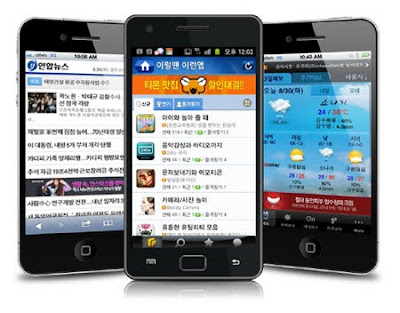
Sanitary and healthcare product manufacturer Yuhan-Kimberly ran an online advertisement for diaper brand Huggies on YouTube in December. It “interpreted” the cooing and gurgling of babies uploaded by parents on the video-sharing website and the ads became popular, often shared on social networking services. “Seventy-six percent of participants were satisfied with the campaign, and 48 percent said their fondness of the brand increased,” said Kim Tae-won, a manager of a media mobile team at Google Korea. The commercial was especially effective as it enabled two-way communication between the advertiser and the consumer, unlike on TV, where the message delivery is one-directional delivery.
Advertisers are increasingly turning to mobile devices as new platforms. Due to the penetration of smart devices and ultra-fast mobile networks, data shows that it has become more influential than television.
According to a survey by Inmobi, a mobile advertisement network, Koreans spend on average 79 minutes per day using mobile devices, excluding voice calls and text messages. Meanwhile, they spend 75 minutes daily watching television.
These devices are also affecting shopping habits. When asked which media influenced their decision on purchases 52 percent picked mobile devices, while 38 percent cited TV.
They also had a positive response toward mobile advertisements. One out of five said they are more convenient and offer more useful information than conventional commercials on TV or others seen online. “Mobile devices have become an essential part of our lives. The survey shows that they have a diverse effect on purchasing or decision making,” said Inmobi Korea CEO Kim Seung-yeon.
For advertisers, mobile ads are attractive as there is no limitation on time or space, on top of being offered in diverse forms such as voice, text or video. While spam has little effect despite considerable cost, mobile ads on smartphones can provide tailored advertisements to target the specific individual.
The Korea Communications Commission estimates that the mobile advertisement market will reach 170 billion won this year and portals as well as mobile carriers are competing for their share. NHN, the operator of the country’s biggest portal Naver, picked mobile keyword advertising as one of its new search engines for this year. It plans to increase sales in mobile keyword advertising three times to 100 billion won this year. Adam, a mobile advertisement network platform by Daum, has been recording over 15 billion views each month. Among carriers, LG Uplus was the first to advance into the mobile advertisement market and SK Telecom, the largest carrier, launched T Ad, a mobile ad platform where one can insert advertisements in applications such as games and comics.
Tips for success
Yeom Dong-hoon, managing director of Google Korea, picked “mobile,” “entertainment,” and “social” as the main keywords in digital advertising trends this year.
“Conventional advertisements were simple; users watched banner advertisements on their desktops. Now, the advertisements will shift to mobile devices where consumers and the advertisers can interact through funny commercials,” he said.
Google advises that advertisements should be humorous and induce users to participate. “The boundary between advertising and entertainment is becoming blurred,” he said.
Many people are enjoying commercials through video platforms like YouTube and they are sharing and expanding the reach of interesting ones through smartphones and tablets. Mobile advertisements have become something for users to participate in and enjoy, not simply something to see.
Google expects that social activities based on direct communication between people will play a bigger role in advertising. It points out that people generally trust people they know more. Hence, advertisements become much more effective when spread among friends through media such as YouTube, Twitter, Facebook and Google Plus.

No comments:
Post a Comment